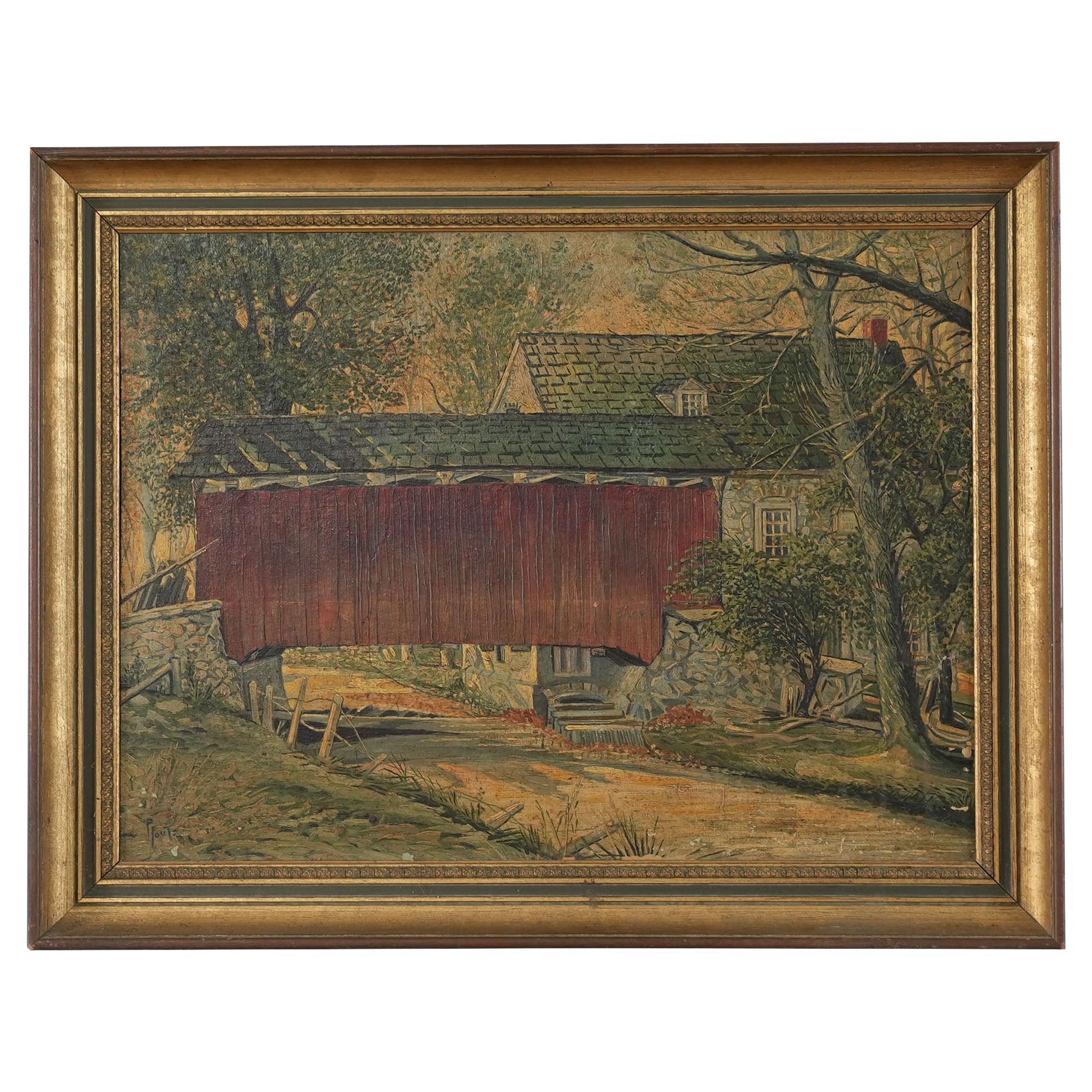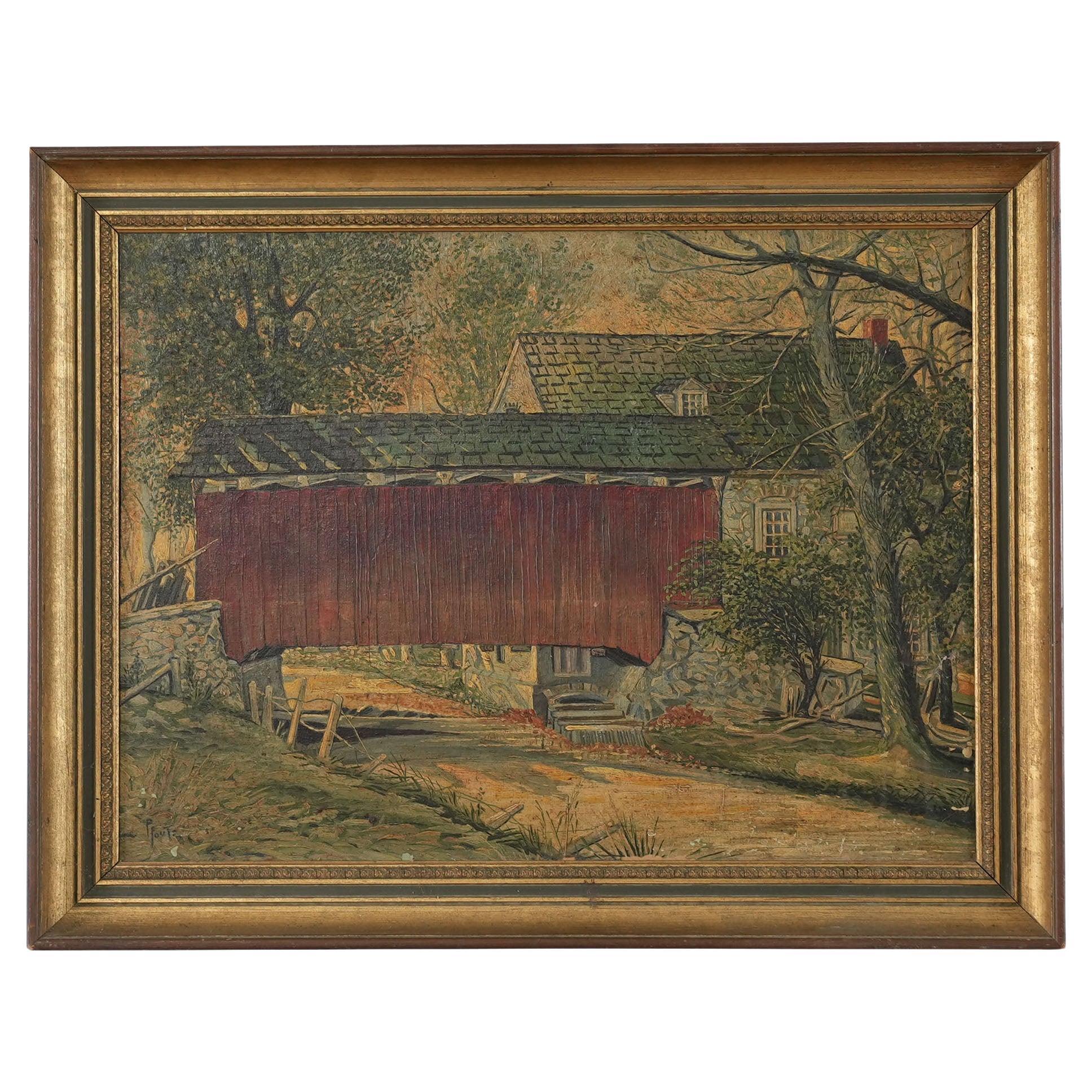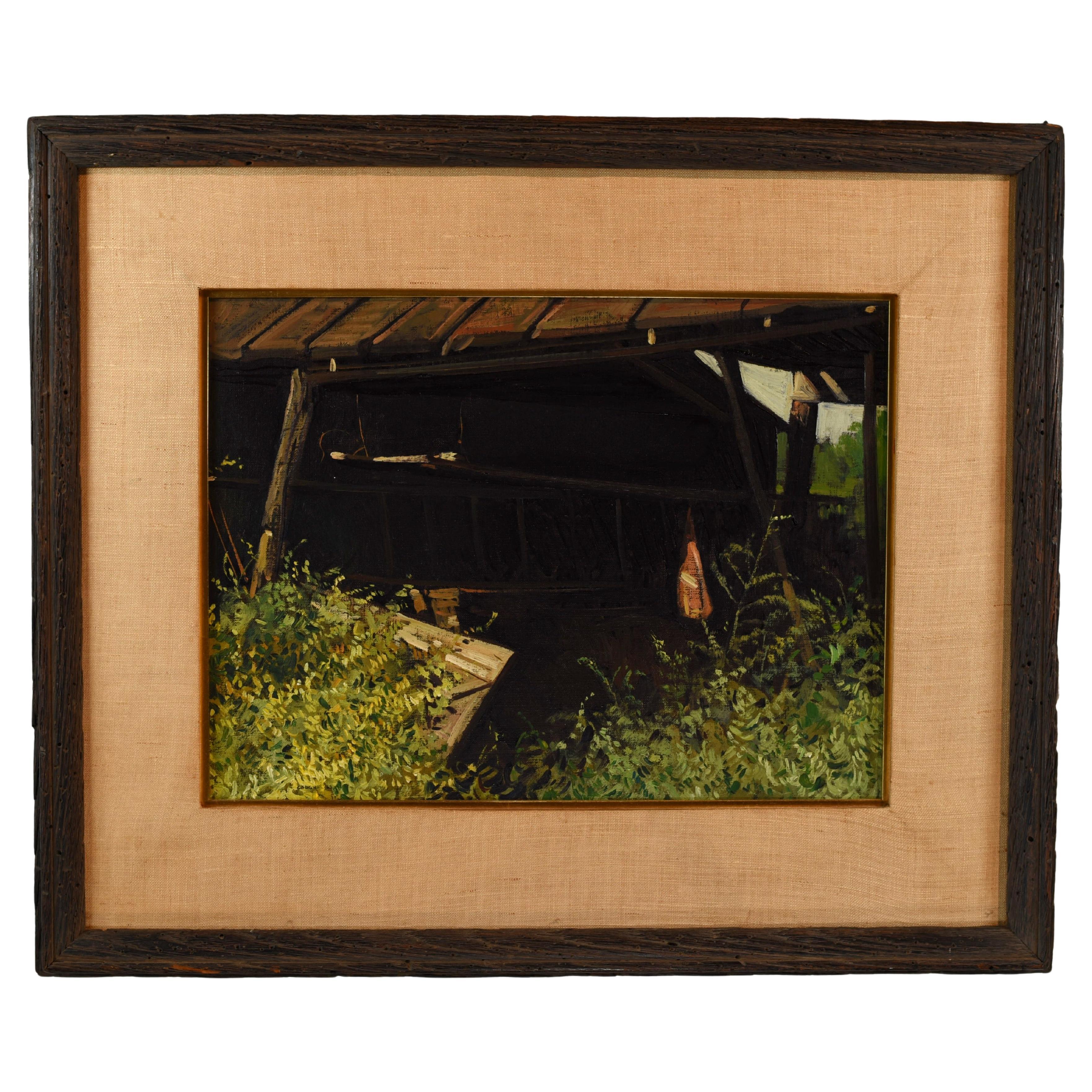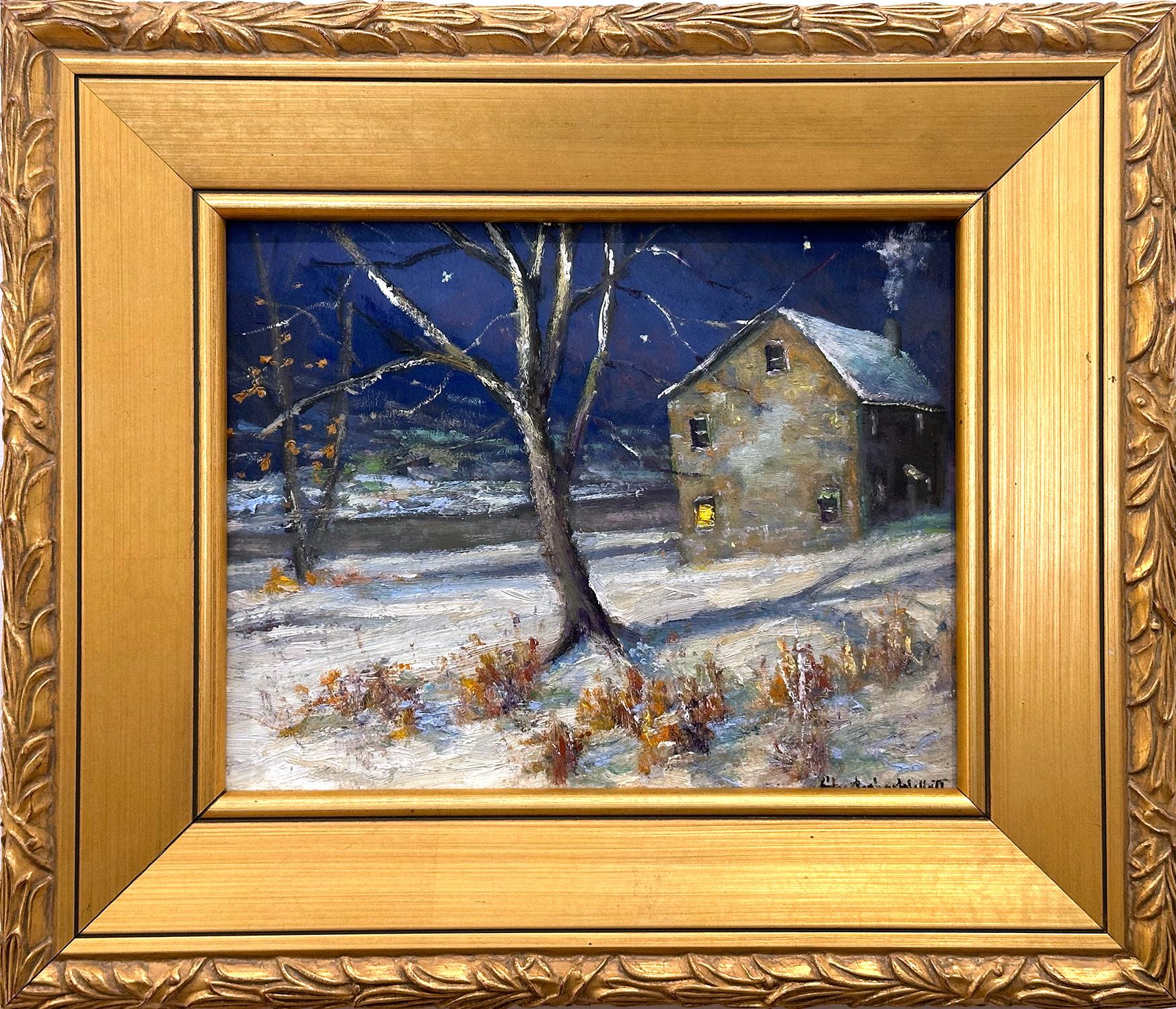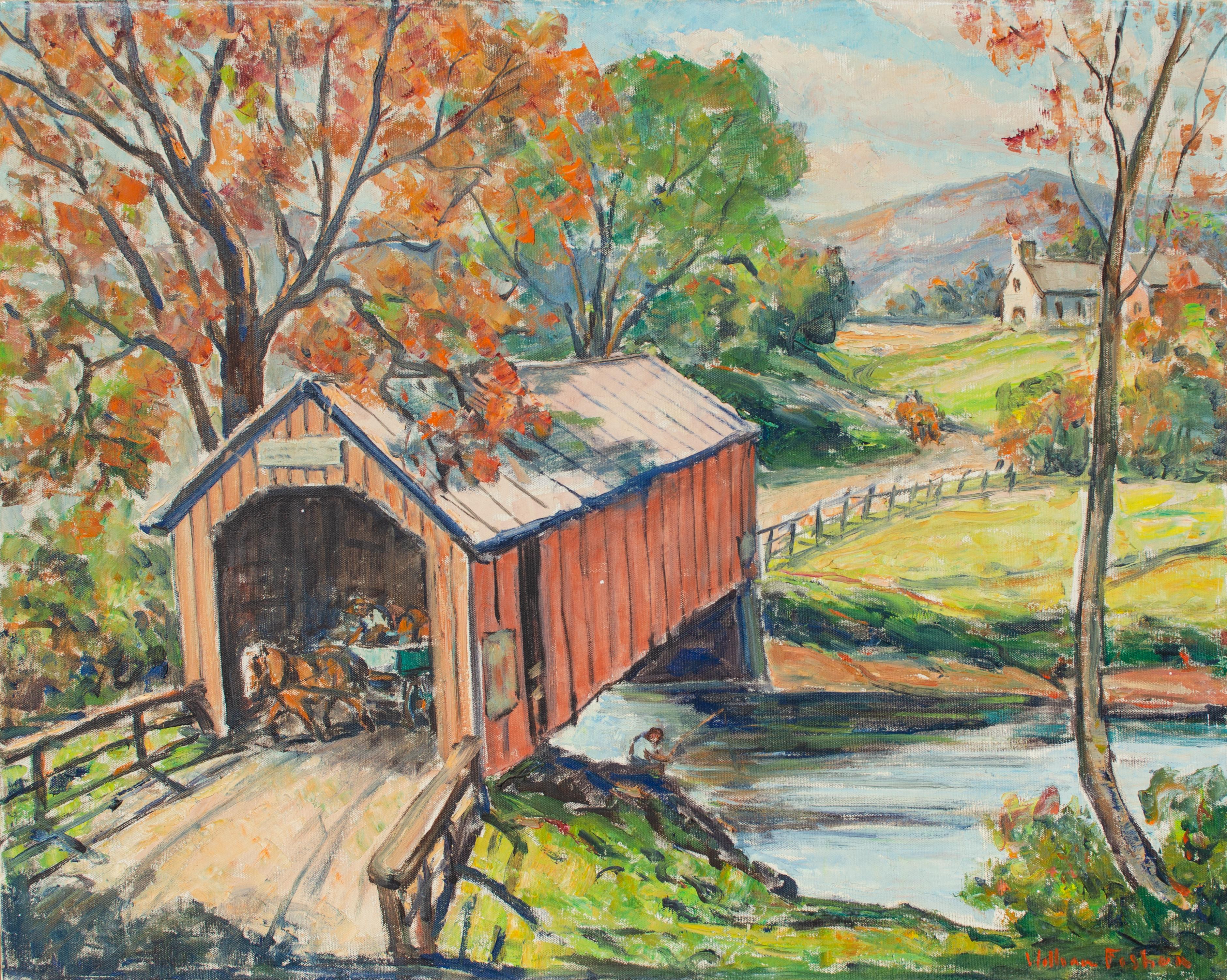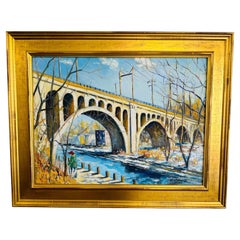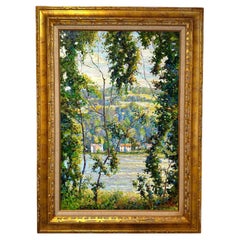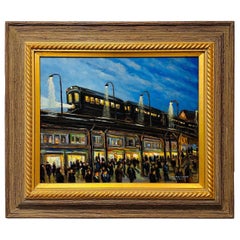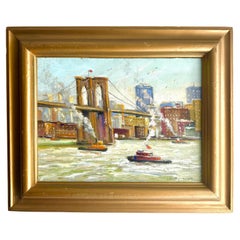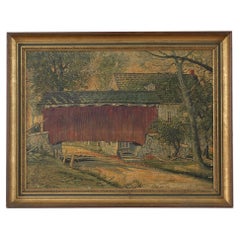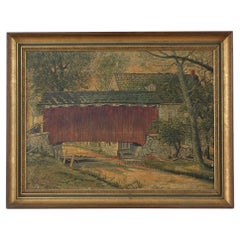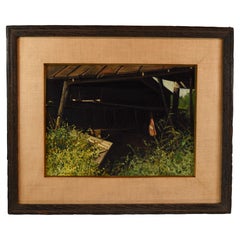Items Similar to Cabin Run Covered Bridge Bucks County Pennsylvania Impressionist Oil Painting
Want more images or videos?
Request additional images or videos from the seller
1 of 10
Cabin Run Covered Bridge Bucks County Pennsylvania Impressionist Oil Painting
$6,000
£4,552.66
€5,205.56
CA$8,380.37
A$9,317.83
CHF 4,865.26
MX$113,420.74
NOK 62,078.59
SEK 58,164.67
DKK 38,850.07
Shipping
Retrieving quote...The 1stDibs Promise:
Authenticity Guarantee,
Money-Back Guarantee,
24-Hour Cancellation
About the Item
Impressionist Bucks County - Winter is here and the calmness of night is approaching. A covered bridge gently perched above a lively stream with banks of fresh snow. The ground is covered in a layer of snow, as the water flows by and the houses begin to light up for evening festivities. From early childhood to the present, Willett, a natural talent carried on the tradition in the arts. Currently as a painter in the New Hope, Bucks County Impressionist style- he works full time in the mediums of oil on board or canvas, and watercolor. His recent work has been compared to Edward Redfield both in subject and style. Earlier works by Willett are reminiscent of the photographic representational influence of Andrew Wyeth- his revered friend and mentor. Upon reviewing Chris's portfolio that spans 3 decades, one can see the gradual evolution and development of Chris' own unique method and artistic language- he portrays the landscape and daily lives of the people that live and have lived in this locale- spanning the region from Bucks County, New Hope, Lambertville, New Jersey, French Town, Point Pleasant, and such- still the most popular subject matter of local contemporary impressionists today.
Painting measures: 30 x 25 inches.
Frame measures: 35 1/2 x 30 1/2 inches.
Oil on board signed lower right corner and verso.
Christopher Willett, born in 1959, is a Bucks County painter with a family lineage dating back to ancestors arriving in this country aboard the Mayflower and Victory, settling Plymouth. The family history is interesting, as another Willett ancestor, Augustine Willett was a Captain of historic repute under the command of General Washington, and is recorded in history books. Additionally, in more recent history, Willett artisans became renowned for their designs and beautiful works in stained glass that adorn the Bryn Athen Cathedral- of the Pit Cairn Estate. Willett, is also a descendant of the renowned painter Edward Hicks, known for his work entitled Peaceable Kingdom, and whom after the Hicks Art Center of Bucks County Community College was named.
From early childhood to the present, Willett, a natural talent carried on the tradition in the arts. Currently as a painter in the New Hope, Bucks County Impressionist style- he works full time in the mediums of oil on board or canvas, and watercolor. His recent work has been compared to Edward Redfield both in subject and style. Earlier works by Willett are reminiscent of the photographic representational influence of Andrew Wyeth- his revered friend and mentor. Upon reviewing Chris's portfolio that spans 3 decades, one can see the gradual evolution and development of Chris' own unique method and artistic language- he portrays the landscape and daily lives of the people that live and have lived in this locale- spanning the region from Bucks County, New Hope, Lambertville, New Jersey, French Town, Point Pleasant, and such- still the most popular subject matter of local contemporary impressionists today.
Working from his studios in Lahaska and Plumsteadville, Chris captures the beauty and simplicity of an earlier time- horse drawn carriages, families working together, villages and farms, and friends taking walks together- and many are depicted in recognizable historic settings. Chris prefers to use a color pallet of rich warm earth tones; consistent with the traditional Bucks County Impressionist style.
Chris attended Hartnell University in California, and Philadelphia Academy of Fine Art. Chris served in the U.S. Navy for 6 years aboard an aircraft carrier and is a decorated veteran. Chris's work is in corporate collections, and in many private collections.
- Creator:Christopher Willett (Artist)
- Dimensions:Height: 30.5 in (77.47 cm)Width: 35.5 in (90.17 cm)Depth: 2 in (5.08 cm)
- Style:American Classical (In the Style Of)
- Materials and Techniques:
- Period:
- Date of Manufacture:circa 20th Century
- Condition:
- Seller Location:Philadelphia, PA
- Reference Number:1stDibs: LU6173242119342
About the Seller
No Reviews Yet
Vetted Professional Seller
Every seller passes strict standards for authenticity and reliability
1stDibs seller since 2021
9 sales on 1stDibs
- ShippingRetrieving quote...Shipping from: Philadelphia, PA
- Return Policy
Authenticity Guarantee
In the unlikely event there’s an issue with an item’s authenticity, contact us within 1 year for a full refund. DetailsMoney-Back Guarantee
If your item is not as described, is damaged in transit, or does not arrive, contact us within 7 days for a full refund. Details24-Hour Cancellation
You have a 24-hour grace period in which to reconsider your purchase, with no questions asked.Vetted Professional Sellers
Our world-class sellers must adhere to strict standards for service and quality, maintaining the integrity of our listings.Price-Match Guarantee
If you find that a seller listed the same item for a lower price elsewhere, we’ll match it.Trusted Global Delivery
Our best-in-class carrier network provides specialized shipping options worldwide, including custom delivery.More From This Seller
View AllMorning Walk on the Manyaunk Philadelphia Bridge Impressionist Oil Painting
By Christopher Willett
Located in Philadelphia, PA
Impressionist large Philadelphia - A brisk morning walk under the Manayunk bridge. A bundled up man takes a stroll along the canal trail. A historic Philadelphia bridge cascades acro...
Category
Late 20th Century American Classical Paintings
Materials
Canvas, Paint
Bucks County Delaware River Lumberville Impressionist Tree Scene Oil Painting
By Christopher Willett
Located in Philadelphia, PA
Impressionist and scenic Bucks County Pa, a fresh morning on the Delaware River. Depicting the views across the Delaware River of the quaint village banks of Lumberville. The village...
Category
Late 20th Century American Classical Paintings
Materials
Canvas, Paint, Wood
"The EL, New York City" Impressionist Busy Train Station Oil Painting by Willett
By Christopher Willett
Located in Philadelphia, PA
Impressionist New York City bustling train station city-scene depicting the "EL" train with pedestrians in a starry, yet energetic way. Busy New Yorker’s daily travels with the sun setting on the elevated train. From early childhood to the present, Willett, a natural talent carried on the tradition in the arts. Currently as a painter in the New Hope, Bucks County Impressionist...
Category
20th Century American American Classical Paintings
Materials
Acrylic
Morning on East River New York City Impressionist Bridge Boat Scene Oil Painting
By Christopher Willett
Located in Philadelphia, PA
Impressionist New York City a wonderful morning on the East River. Tug boats gently make their way up the river with a backdrop of the Brooklyn Bridge. Birds flying in the crisp morn...
Category
Late 20th Century American Classical Paintings
Materials
Canvas, Paint
New York City Guggenheim Museum Frank Lloyd Wright Impressionist Oil Painting
By Christopher Willett
Located in Philadelphia, PA
Impressionist New York City, an evening at the Guggenheim. Tourist and locals alike flock to the Solomon R. Guggenheim Museum on the upper east side. Lights show off the famous build...
Category
Late 20th Century American American Colonial Paintings
Materials
Canvas, Paint
"Boathouse Central Park, New York City" Impressionist Spring Scene Oil Painting
By Christopher Willett
Located in Philadelphia, PA
Impressionist New York City peaceful Central Park Boathouse scene depicting fully bloomed trees with pedestrians and sail boats enjoying a leisurely day. Birds flying high above the ...
Category
20th Century North American American Classical Paintings
Materials
Acrylic
You May Also Like
Lancaster Covered Bridge Original Oil Painting
Located in Annville, PA
A very interesting and unusual Lancaster Covered Bridge Original Oil Painting by artist J. Earle Pfoutz. The painting is produced on artist board and comes complete with what appears to be an original artist decorated/painted frame. The painting is signed on the front by the artist and is dated 1936 on the rear.
Overall frame Size approximately 28″ wide x 2″ deep x 22″ high
J. Earle Pfoutz had a long and distinguished career as a self trained artist. More can be learned about him from reading this article produced by Gary Hawbaker at askART
Earle Pfoutz Born: 1891 – Lancaster, Pennsylvania
Died: 1957
Known for: Landscape, figure, still life painting
An image of J Earle Pfoutz
Biography from the Archives of askART
J. Earle Pfoutz (John Earle Pfoutz) – (Oct 23, 1891-Nov 9, 1957)
“A seventh generation descendant of a Swiss family which arrived in America early in the 17th Century, J. Earle Pfoutz was born in Lancaster, PA, son of John Bachman and Susan Allison Pfoutz. He painted houses for a living and pictures for a life.
A self-taught artist, described as a primitive, he was distinctive for his vivid imagination and bold color application. He painted hundreds of Lancaster County scenes. Pfoutz traveled through the hills near his home and along the Susquehanna River in search of scenes. He began painting with a brush when he was fourteen, but added a palette knife after suffering an eye injury. He completed eighth grade in the Lancaster Public Schools and there his formal education ended. However, the Department of Public Instruction of the State of Pennsylvania thought so highly of his work as an artist that officials certified him as an art instructor and he taught for a year in the York (PA) public schools. He also was an art instructor under the program for disabled veterans, sponsored by the Veterans Administration, when he gave private instruction to veterans in their homes.
In 1947, J. Earle Pfoutz finally earned national recognition as an artist. His painting, Opalescent October, was chosen by the Museum of Art of Dayton Ohio, to travel all over the country for a year with its Group Exhibition. Described as a “very colorful, calm scene, iridescent in color, sweeping in design,” the painting started on its journey around the country early in 1948. In an interview with the Sunday News (Lancaster, PA – Nov 2, 1947), Pfoutz stated that he didn’t know whether he was a “primitive” or an “impressionist.” No master taught him, no school channeled his style. “Sometimes I didn’t eat, but I always managed to paint,” he recalled. Many of his hundreds of canvases -most of them not sold, but given away to friends – found their way to other parts of the country. “I never remember the day when I did not love color,” Pfoutz said. “I was about 12 years old when I saw my first palette – a string of different colored paint paddles that graced the stores of that day. As a boy I had two great desires. One was to be able to eat all the strawberry jam I could, and the other to possess a string of those beautiful paint paddles. Well, I’ve got my fill of jelly, but I’ve never yet got my fill of beautiful colors.”
In 1950, Pfoutz’s one man show of paintings made front page headlines in the Lancaster Intelligencer Journal: “Most of the twenty oil paintings on exhibition are landscapes, although there are several interesting figure studies. Colors again, as in all Pfoutziana are rich and full-bodied, but for the most part not as startlingly as in some of the earlier work. Most of the paintings were done during the past year, and also reveal the painter’s characteristic heavy impasto technique, in which the rich swirls of paint carry their own message. Among the figures, The Banjo Picker, and The Magician, are the most provocative. Both are character studies; the first being of a tramp musician whose drab clothing is set-off by a luminous aqua blue background. Modern in feeling and treatment is The Magician, a clown-faced wizard whose spinning ball in the air suggests the fourth dimension – space. The use of the primary colors in this picture serves to emphasize the theme effectively.
A large colorful landscape, Opalescent October, depicting rolling hills against a late afternoon sky is new to Lancastrians, as it has just returned from Dayton, Ohio, where it hung in the Dayton Art Institute. Another landscape with soft dreamy colors is Fantasie D’Autumne, and one of the loveliest pictures in the show. Pennsylvania Dutch Country is another with eye appeal, and was one of the works which was hung in the Old Customs House in Philadelphia during Pennsylvania Week, and before that in a collection of Pfoutz work in the same place. In deep contrast to the sunny skies and brilliant foliage of many of the pictures, is the somewhat morbid Worry, in which the center of interest is a tremendous rat. This, the painter explains, was symbolic of 1948 in China, which was ‘The Year of The Rat’ in the Chinese calendar. Background material for the picture was furnished to Pfoutz by author Pearl Buck.
Other pictures include Autumn Prelude, Miners Village, painted at Cornwall, PA; Humid Day, Saint Peters Kierch, at Middletown, PA; Lady Pfoutz, inspired by the painter’s wife; Sun Flowers, Sentimental Journey, Gyne, Luzon Woman, Old Bridge, The Cow Path. Lemures, based on Roman mythology, and Ethiopian, painted from an ebony wood carving from Kenya Province, S. Africa.”
In 1953, Pfoutz was installed as President of the Lancaster County Art Association. A. Z. Kruse, New York City artist, writer and member of the faculty of the Brooklyn College and the Cartoonists and Illustrators School, Manhattan, was the guest speaker. In January of 1953, thirty-five Pfoutz oils were exhibited at the Old Custom House in Philadelphia, PA under the sponsorship of the Carl Schurz Memorial Foundation. Several Lancaster County landscapes and covered bridges were included as well as Katy, a Pennsylvania Dutch scene. Symbolic paintings included End of the Second Day, the artist’s visualization of the second coming of Christ, and Twilight, typifying the grief of mothers of all lands for sons lost in battle.
In June of 1953, a Pfoutz oil made history in Lancaster. From the Lancaster New Era: “For the first in local art history, a painting has been withdrawn from an exhibition because of objections from viewers and hostesses serving at the show. The painting, Jeune Fille, a standing nude done by Pfoutz, was one of the paintings in the annual spring exhibition of the Art Association and had become the center of the controversy. Pfoutz said he took the painting down… ‘graciously but reluctantly.’ ‘From an artistic standpoint, there is nothing offensive about the painting,’ Pfoutz said. ‘This community just wants its nudes with clothes on.’ “It is most brilliant in color, and because it is so brilliant I thought it would make a nice lively spot for the show. This is the first time I’ve had to take a picture off the walls. I substituted a seascape for it.’ Pfoutz said he felt the painting brought a lot of viewers to the show because it was so controversial. It had never been exhibited before. ‘If this had been shown in a metropolitan city,’ he commented, ‘people wouldn’t have given it a second glance. But the viewpoint here is more conservative, even though I don’t think moderns would have minded.’ He said he felt the painting was neither ‘objectionable nor pornographic,’ but had complied with the wishes of fellow members of the Art Association who telephoned him to relay the protests they had received. The art controversy was the first to arise here publicly since the showing of Amish Grandmother, an oil by William Gropper which was part of the Gimbel Pennsylvania exhibit at the Griest Building several years ago. — Numerous viewers of Amish Grandmother, [a painting showing an Amish woman holding a white goose], expressed themselves quite vocally, calling it an affront to the Plain Folk. But it stayed on exhibit throughout the length of the Gimbel show. Pfoutz expressed no rancor, implying that if Gropper could take it so could he.”
After his death, there were several shows of Pfoutz’ work organized by his son J. Earle, Jr. J. Earle, Jr. also saw to it that President Eisenhower would receive an oil called The Cow’s Path. The president first saw the painting in 1950 when, as president of Columbia University, he visited Lancaster to address a student assembly at Franklin and Marshall College. After his address was over, the then Gen. Eisenhower stopped at the Fackenthal Library on the campus to view an exhibition of Pfoutz’s paintings. The Cow’s Path intrigued him. For some time, as his aides fumed to get him back on his time schedule, Eisenhower and Pfoutz talked, as artist to artist. Prior to his death, Pfoutz requested that The Cow’s Path be given to the President if he wanted it. The painting was presented to Ike at the White House in November of 1959. Mrs. Eisenhower owned a Pfoutz painting titled, In the Manor.
Though house painting was his livelihood, he worked for Millersville State Teachers College (now a university) for a time during World War II, and called himself “the Chimney Sweep of MSTC.” During that period he knocked out a dizzying canvas in the surrealist style (he thought it was terrible) and got into the campus newspaper when one of the students spotted it.
Earle Pfoutz was not the humble, downtrodden artist, not the Douanier Rousseau type at all. As he developed his skill and style through the years, he also fashioned a resilient confidence in himself as an artist. Whether he was building his own home (he built two) or painting one for somebody else, he never lost faith in his ultimate recognition—though he was never sure he would live to see it.
Whether he was working as a rigger for a hoisting company, in the Stehli Silk Mill of Lancaster, carving Cloister-style chairs, decorating old chests, cementing bricks from the old Safe...
Category
Vintage 1940s American Paintings
Materials
Paint
PA American Impressionist Bucks CO. Covered Bridge Landscape Oil Painting
Located in Wilton Manors, FL
Gorgeous ca.1925 PA Impressionist painting of a covered bridge.
Oil on canvas measuring 22 x 28 inches. Framed measurement: 27 x 33 inches. Unsigned.
There is a puncture in canva...
Category
1920s Abstract Impressionist Landscape Paintings
Materials
Oil
$1,000 Sale Price
50% Off
Lancaster Covered Bridge Original Oil Painting
Located in Annville, PA
A very interesting and unusual Lancaster Covered Bridge Original Oil Painting by artist J. Earle Pfoutz. The painting is produced on artist board and comes complete with what appears to be an original artist decorated/painted frame. The painting is signed on the front by the artist and is dated 1936 on the rear.
Overall frame Size approximately 28″ wide x 2″ deep x 22″ high
J. Earle Pfoutz had a long and distinguished career as a self trained artist. More can be learned about him from reading this article produced by Gary Hawbaker at askART
Earle Pfoutz Born: 1891 – Lancaster, Pennsylvania
Died: 1957
Known for: Landscape, figure, still life painting
An image of J Earle Pfoutz
Biography from the Archives of askART
J. Earle Pfoutz (John Earle Pfoutz) – (Oct 23, 1891-Nov 9, 1957)
“A seventh generation descendant of a Swiss family which arrived in America early in the 17th Century, J. Earle Pfoutz was born in Lancaster, PA, son of John Bachman and Susan Allison Pfoutz. He painted houses for a living and pictures for a life.
A self-taught artist, described as a primitive, he was distinctive for his vivid imagination and bold color application. He painted hundreds of Lancaster County scenes. Pfoutz traveled through the hills near his home and along the Susquehanna River in search of scenes. He began painting with a brush when he was fourteen, but added a palette knife after suffering an eye injury. He completed eighth grade in the Lancaster Public Schools and there his formal education ended. However, the Department of Public Instruction of the State of Pennsylvania thought so highly of his work as an artist that officials certified him as an art instructor and he taught for a year in the York (PA) public schools. He also was an art instructor under the program for disabled veterans, sponsored by the Veterans Administration, when he gave private instruction to veterans in their homes.
In 1947, J. Earle Pfoutz finally earned national recognition as an artist. His painting, Opalescent October, was chosen by the Museum of Art of Dayton Ohio, to travel all over the country for a year with its Group Exhibition. Described as a “very colorful, calm scene, iridescent in color, sweeping in design,” the painting started on its journey around the country early in 1948. In an interview with the Sunday News (Lancaster, PA – Nov 2, 1947), Pfoutz stated that he didn’t know whether he was a “primitive” or an “impressionist.” No master taught him, no school channeled his style. “Sometimes I didn’t eat, but I always managed to paint,” he recalled. Many of his hundreds of canvases -most of them not sold, but given away to friends – found their way to other parts of the country. “I never remember the day when I did not love color,” Pfoutz said. “I was about 12 years old when I saw my first palette – a string of different colored paint paddles that graced the stores of that day. As a boy I had two great desires. One was to be able to eat all the strawberry jam I could, and the other to possess a string of those beautiful paint paddles. Well, I’ve got my fill of jelly, but I’ve never yet got my fill of beautiful colors.”
In 1950, Pfoutz’s one man show of paintings made front page headlines in the Lancaster Intelligencer Journal: “Most of the twenty oil paintings on exhibition are landscapes, although there are several interesting figure studies. Colors again, as in all Pfoutziana are rich and full-bodied, but for the most part not as startlingly as in some of the earlier work. Most of the paintings were done during the past year, and also reveal the painter’s characteristic heavy impasto technique, in which the rich swirls of paint carry their own message. Among the figures, The Banjo Picker, and The Magician, are the most provocative. Both are character studies; the first being of a tramp musician whose drab clothing is set-off by a luminous aqua blue background. Modern in feeling and treatment is The Magician, a clown-faced wizard whose spinning ball in the air suggests the fourth dimension – space. The use of the primary colors in this picture serves to emphasize the theme effectively.
A large colorful landscape, Opalescent October, depicting rolling hills against a late afternoon sky is new to Lancastrians, as it has just returned from Dayton, Ohio, where it hung in the Dayton Art Institute. Another landscape with soft dreamy colors is Fantasie D’Autumne, and one of the loveliest pictures in the show. Pennsylvania Dutch Country is another with eye appeal, and was one of the works which was hung in the Old Customs House in Philadelphia during Pennsylvania Week, and before that in a collection of Pfoutz work in the same place. In deep contrast to the sunny skies and brilliant foliage of many of the pictures, is the somewhat morbid Worry, in which the center of interest is a tremendous rat. This, the painter explains, was symbolic of 1948 in China, which was ‘The Year of The Rat’ in the Chinese calendar. Background material for the picture was furnished to Pfoutz by author Pearl Buck.
Other pictures include Autumn Prelude, Miners Village, painted at Cornwall, PA; Humid Day, Saint Peters Kierch, at Middletown, PA; Lady Pfoutz, inspired by the painter’s wife; Sun Flowers, Sentimental Journey, Gyne, Luzon Woman, Old Bridge, The Cow Path. Lemures, based on Roman mythology, and Ethiopian, painted from an ebony wood carving...
Category
Early 20th Century North American Paintings
Materials
Canvas, Paint
Impressionist American School Oil on Canvas Landscape Barn Painting Signed
Located in Sarasota, FL
Original oil painting, signed in tiny script that has not been deciphered. Oil on canvas of what appears to be a crab shack or barn.
Category
Mid-20th Century American Adirondack Paintings
Materials
Paint
"Along the Tinicum Creek" Bucks County PA Snow Scene Landscape Oil Painting
Located in New York, NY
Impressionist winter pastoral scene of a quaint snow covered home in Tinicum, Bucks County, PA. Willett has portrayed this charming scene in a most intimate, yet energetic way, and h...
Category
20th Century American Impressionist Landscape Paintings
Materials
Oil, Board
New England Country Side Covered Bridge Painting by Maine artist William Fisher
Located in New York, NY
William Fisher (American, 1891-1985)
Untitled (Covered Bridge), 20th century
Oil on canvas
24 x 30 in.
Signed lower right: William Fisher
William Fisher was born in Brooklyn, NY in 1891. He studied at the Brooklyn Institute of Art and Science and at Pratt Institute. Following service as an ambulance driver in WWI, he remained in Europe after the war and studied painting in Rome, Italy for one year. Upon his return from Rome, to New Jersey, he pursued his painting and began to teach small art classes.
In the 1920's Fisher became a successful illustrator. His work appeared in Saturday Evening Post, Mc Calls, Harpers and other popular magazines. He later did pen and ink sketches for the "Villager," a weekly Greenwich Village newspaper. Microfilmed pages of the Villager are preserved in New York University's Washington Square Library. His sketches also appeared on the cover of the "Gotham Guide," which was sold Fridays at news stands in Manhattan.
In partnership with Margaret Kilburn, an artist and crafts person, Fisher opened an art gallery and school at 33 West 8th St in NYC during the 1930's. They also opened a summer art gallery and school in 1949 in Kennebunkport, Maine, which ran for many years, and, after the NY gallery closed (around 1952), they made a full time commitment to living and working in Kennebunkport, Maine. Fisher was the recipient of over 100 awards. His work was widely exhibited in Philadelphia,Pa., Montclair, Trenton, and Newark, NJ, the Currier Gallery in New Hampshire and the Brick Store Museum in Kennebunk, Maine.
William Fisher and Margaret Kilburn were familiar and beloved figures in Kennebunkport. They taught generations of local children, and they participated in numerous exhibits with other artists, both in the Kennebunkport area and throughout Maine. Mr Fisher always insisted on marching in the local Memorial Day parade, until he was well in his 90's, because he didn't want to ride in a car provided for older veterans. Many homes in the Kennebunks have his works, including members of the Bush family, and they were purchased by numerous out of state and Canadian summer visitors. There are several examples of his works in the Kennebunkport Town Offices and in local churches.
Fisher loved to paint "big" canvases, usually local Maine scenes...
Category
20th Century Abstract Impressionist Landscape Paintings
Materials
Canvas, Oil
More Ways To Browse
Vintage Willett Furniture
Wall Mounted Sword
Wood Rocking Horses
19th Century Girandole Mirror
1920 Art Deco Beds
1920s Egyptian Revival
Aesops Fables
Agave Plant
Aksel Kjersgaard Rosewood
Altar Box
Andree Putman
Antique Black Lacquer Inlay
Antique Booths
Antique Dispenser
Antique Folding Bed
Antique Folding Beds
Antique German Helmets
Antique German Lighter
